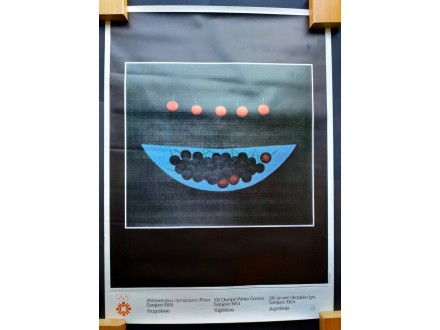YOZO HAMAGUCHI - Sarajevo 1984 - PLAKAT
| Cena: |
7.900 din
(Predmet je prodat)
|
| Stanje: | Kolekcionarski primerak |
| Garancija: | Ne |
| Isporuka: | Pošta Post Express |
| Plaćanje: | Tekući račun (pre slanja)
PostNet (pre slanja) |
| Grad: |
Beograd-Stari grad, Beograd-Stari grad |
Tip: Plakat
Tema: Sport
OVO JE ORIGINALNI PLAKAT ZIMSKE OLIMPIJADE u SARAJEVU 1984
62 x 85 cm
urolan
samo srbija
ovaj plakat ne saljem u inostranstvo
XIV Zimske olimpijske igre su održane 1984. godine u Sarajevu, tadašnjoj Socijalističkoj Federativnoj Republici Jugoslaviji. Ostali gradovi kandidati za Olimpijske igre su bili Saporo, Japan i Falun/Geteborg, Švedska.
Ovo su bile prve zimske i druge zaredom igre generalno održane u Istočnoj Evropi, na govornom području slovenskih jezika i u socijalističkoj zemlji, kao i prve i za sada jedine Olimpijske igre održane u državi iz Pokreta nesvrstanih i u većinski muslimanskom gradu. Takođe, ovo je bilo prvi put da se Olimpijske igre organizuju na Balkanskom poluostrvu nakon prvih u modernom dobu u Atini.
Sarajevo je organizaciju zimskih olimpijskih medalja dobilo u konkurenciji s japanskim Saporom i zajedničkom kandidaturom švedskih gradova Falun i Geteborg. MOK se pri tome delimično vodio političkim razlozima - kao nesvrstana zemlja, tadašnja Jugoslavija je davala manje prilike za hladnoratovske bojkote - ali glavni je motiv ipak bila želja da se Igre, kao simbol svjetskog mira i bratstva među ljudima - održe u gradu koji je dotada obično bio vezivan za izbijanje Prvog svjetskog rata.
Za vlasti Jugoslavije sarajevske Olimpijske igre su bile sjajna prilika da državu svetu predstave u najboljem mogućem svetlu, i u tom nastojanju ih nije omela ni velika ekonomska kriza koja je SFRJ bila pogodila početkom 1980-ih. U Igre su utrošena velika sredstva, te sagrađen veliki broj impozantnih građevina i ostale infrastrukture. U tome su vlasti imale podršku Sarajlija, a već pre samog održavanja su Igre dovele do povećanja interesa za zimske sportove, dotada gotovo nepoznate u tom delu Jugoslavije.
------------------------------------------------
this is an original poster by YOZO HAMAGUCHI
print - offset lithography
62 x 85 cm, 24,4 x 33,5 in
serbia only
I do not send this poster abroad
The poster has the official Yugoslavian Olympic logo in the lower left corner along with the 1984 official logo and is an official Olympics poster.
The 1984 Winter Olympics, officially known as the XIV Olympic Winter Games (French: XIVes Jeux olympiques d`hiver; Serbo-Croatian: XIV. zimske olimpijske igre / XIV Зимске олимпијске игре; Macedonian: XIV Зимски олимписки игри; Slovene: XIV olimpijske zimske igre), was a winter multi-sport event which took place from 8–19 February 1984 in Sarajevo, Yugoslavia, in what is now Bosnia and Herzegovina. Other candidate cities were Sapporo, Japan; and Gothenburg, Sweden.
It was the first Winter Olympic Games held in a socialist state and in a Slavic language-speaking country. It was also the second Olympics overall, as well as the second consecutive Olympics, to be held in a socialist and in a Slavic language-speaking country after the 1980 Summer Olympics were held in Moscow, Soviet Union. Furthermore, it was the first Olympics held in the Balkans after the first modern Games in Athens. The Sarajevo games have also been the only Olympics so far to be hosted by a Non-Aligned Movement member.
The host city for the XIV Winter Olympics was announced on 18 May 1978 during an 80th session of the International Olympic Committee in Athens, Greece. Sarajevo was selected over Sapporo, Japan (which hosted the games 12 years earlier) by a margin of three votes. Gothenburg was the first city in Sweden to lose a Winter Olympics bid, as other Swedish cities such as Falun and Östersund would later lose their consecutive bids to Calgary, Albertville, Lillehammer, Nagano, and Salt Lake City respectively. Sarajevo, capital of present-day Bosnia and Herzegovina, was part of the united Yugoslavia at the time.
The torch relay for the 1984 Winter Olympics started in Olympia and then proceeded by airplane to Dubrovnik. The total distance of the torch relay through Yugoslavia was 5,289 kilometres (3,286 mi) (plus 2,879 kilometres (1,789 mi) of local routes). There were two main routes – one in the west (Split – Ljubljana – Zagreb – Sarajevo with 2,602 kilometres (1,617 mi) of length) and the other in the east (Skopje – Novi Sad – Belgrade – Sarajevo with 2,687 kilometres (1,670 mi) of length). The final torchbearer, from a total of 1600, was figure skater Sanda Dubravčić, who received the torch from skier runner Ivo Čarman. Today one of the two original torches is in Slovenia in a private collection in Žalec, Slovenia. Also 20 more torches are in Greece owned by individual athletes, who were the torchbearers from Ancient Olympia to the nearby military airport and from Athens Domestic Airport to the Panathinaikon Stadium where the Ceremony of handing over the Olympic Flame to the Sarajevo Olympic Games Committee occurred.
-------------------------------
Its most distinguished mid-20th-century advocate, Yozo Hamaguchi, a Japanese artist living in Paris, developed techniques for printing colour mezzotint, and other artists, such as Mario Avati of Great Britain and Merlyn Evans of France, have mastered it.
MOLIM CENJENE KUPCE DA ISPOSTUJU PRAVILNIK(ROKOVE) LIMUNDO-KUPINDO TIMA.
ne dajem nikakve popuste.
izlozene cene su KONACNE, bez obzira na kolicinu
NE RAZNOSIM PRODATU ROBU - OVO VAZI I ZA BEOGRAD.
kupci koji `zapinju` da licno preuzmu predmet mogu to
da obave na mojoj adresi (ispred zgrade), posle 18h
placanje na tekuci racun u POSTI - POSTANSKA STEDIONICA,ili POSTNETOM
INO KUPCI -- paypal (+5%) (pitati za postarinu)
INTERNATIONAL BUYERS WELCOME
IF YOU HAVE ANY QUESTION REGARDING CONDITION,SHIPPING AND PRICING PLEASE EMAIL US BEFORE YOU BID. THANK YOU !
NOVAC U PISMU - NE PRIMAM.
slanje POSTEXPRESOM (ili VREDNOSNO PISMO)
ako stoji `besplatna dostava`(pored broja pregleda) onda VAZI SAMO ZA SRBIJU
POUZECEM -- N E S A L J E M
komunikacija iskljucivo preko limundo-kupindo poruka
slike se najbolje vide kada se klikne na `Slika u punoj veličini`
Predmet: 60871513











